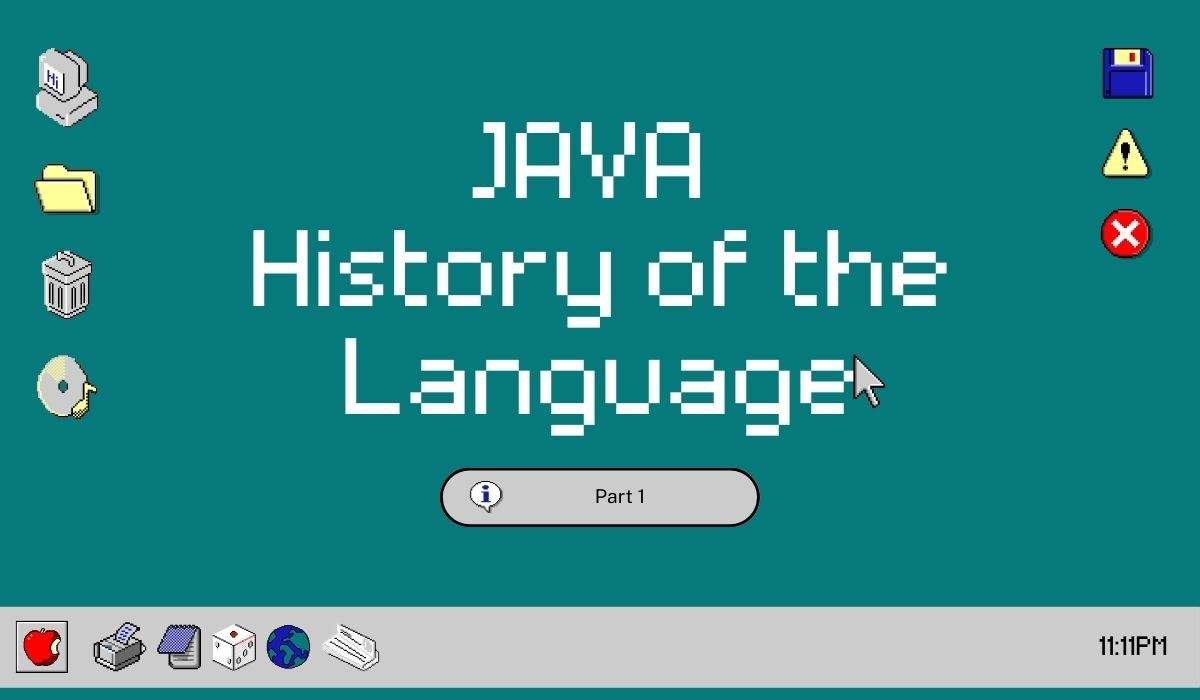Java Through the Ages: A Historical Overview

Java is one of the most popular and influential languages in the world. Its dominance in the industry can be attributed to many reasons including platform independence, a rich standard library, enterprise adoption, and a strong community that works towards its continuous improvement.
In my own software engineering journey, it was the first language I learned, and it remains an important aspect of my career as I develop large-scale web applications. As part of the Software Fundamentals series, I've decided to build out a Java guide I'd initially written during interview prep. For the first post in the series, we will delve into the history of Java and examine its current status.
The Early Days of Java
Java's story begins at Sun Microsystem, where a team led by James Gosling started the Green Project as an initiative to capitalize on the next wave of computing. The team believed that this next wave would involve developing software for the emerging consumer electronics industry.
The team originally considered extended C++ for their needs, but they abandoned the idea for a few reasons: (1) C++'s complexity could lead to developer errors and (2) the lack of garbage collection meant developers would need to handle it on their own. The goal of the project evolved such that the team wanted to create a platform-independent programming language where developers could write code once and run it on any device.
By the summer of 1992, the team had created portions of the new platform including what they called Green OS and a new language called Oak. Their first project was to create a PDA (personal digital assistant) with a graphical user interface. In November of the same year, the Green Project became "Firstperson", a fully-owned subsidiary of Sun Microsystems.
Birth of Java
As the project pushed on, the team at Sun realized that the Oak language had broader applications than just consumer electronics. In the summer of 1994, a group of key members of the project discussed the prevalence of the World Wide Web. The team believed that the emergence of graphical web browsers, such as Mosaic, could transform the internet into an interactive platform. To demonstrate this concept, a compact browser called WebRunner was built, which was later renamed to HotJava in 1995.
The Evolution of Modern Java
Ever since then, Java has introduced the following concepts as part of the language:
Java 1.1 (1997) - The Introduction of Inner Classes and JavaBeans
- Java inner classes are classes defined within another class. They exist to provide a mechanism to logically group classes, which can access members of the outer class.
- JavaBeans are plain Java classes that follow certain conventions: (1) all properties are private (use getter/setters), (2) provide public no-argument constructors, and (3) implement the Serializable interface
Java 1.2 (1998) - The Introduction of the Collections Framework and Swing (and the rest of the Java Foundation Classes were integrated)
- The Collections Framework created a standardized way to interact with, manage, and manipulate groups of objects. The framework encompasses a variety of interfaces, including List, Set, and Map.
- The Java Foundation Classes is a set of Java libraries that provide a framework for building GUIs (graphical user interfaces).
Java 1.3 (2000) - The Introduction of HotSpot JVM
- The HotSpot JVM is Java's default runtime environment that was introduced in 1.3. The HotSpot JVM is known for its Just-In-Time compilation, which compiles Java bytecode into machine code during runtime. The JVM also introduced tools and APIs to monitor and profile Java applications at runtime. This makes it possible for developers to identify performance and memory bottlenecks.
Java 1.4 (2002) - The Introduction of NIO APIs
- NIO stands for New Input/Output. With 1.4, Java introduced new APIs to improve performance and scalability to perform I/O operations. Some of the key features in NIO include the introduction of buffer objects, channels (data transfer between entities), non-blocking and asynchronous I/O, etc.
Java 5 (2004) - The Introduction of Generics, Autoboxing, and Annotations
- Generics allow for the development of more type-safe and reusable code by empowering developers to define type parameters for classes, interfaces, and methods. This is also known as parametric polymorphism, which we go into greater depth in "The 4 Principles of Object-Oriented Programming (A.P.I.E)".
- Autoboxing is a feature in Java that automatically converts primitive types into their corresponding wrapper classes, and vice versa. There are eight primitive types in Java: byte, short, int, long, float, double, char, and boolean. Each of these types has a corresponding wrapper class: Byte, Short, Integer, Long, Float, Double, Character, and Boolean.
- Annotations are a Java feature that allows developers to add metadata-related Java code elements, such as classes, interfaces, methods, and fields. Some examples of these annotations include @Override, @SurpressWarnings, etc. They can be used for various cases such as compiler instructions, code generation, documentation, and runtime processing.
Java 6 (2006) - Performance Support, Web Services Support, and Scripting Language Integration
- Java 6 introduced some performance enhancements to the HotSpot JVM. The changes were made to the JIT compilation and garbage collection to enhance application performance.
- New APIs were introduced to help create, manage, and deploy web services.
- There was new support added to integrate scripting languages via the javax.script AP.
Java 7 (2011) - Introduced Language Improvements and the Fork/Join Framework
- Java 7 introduced some of the following language improvements: (1) the diamond operator (<>) to simplify generics syntax, (2) strings in switch statements, and (3) the try-with-resources statements which introduced an AutoCloseable interface to assist with automatic resource management
- A Fork/Join Framework was a parallel programming framework to assist with dividing tasks into smaller subtasks.
Java 8 (2014) - Introduced Lambda Expressions, the Streams API, and Default Methods
- The introduction of lambda expressions introduced functional programming to Java. It provided a simple way to pass anonymous functions around and is particularly useful when working with functional interfaces.
- The Streams API is a potent functional programming feature that enables developers to handle data collections using a declarative and functional approach.
- Default methods were introduced to allow developers to add methods with default method implementations to interfaces.
There are many more changes that have taken place since 2014, but these are the primary changes that have shaped Java into what it is today. Along with these language evolutions, Java has also seen many frameworks, libraries, and tools develop around it. Frameworks such as Spring and Hibernate have made it easier to build complex Java applications and tools such as Maven have helped to streamline the development process.
Conclusion
Since its modest inception in the 90s, Java has evolved into a dominant force in global software development. In subsequent articles, we will delve deeper into the various language-specific features. Stay tuned!


